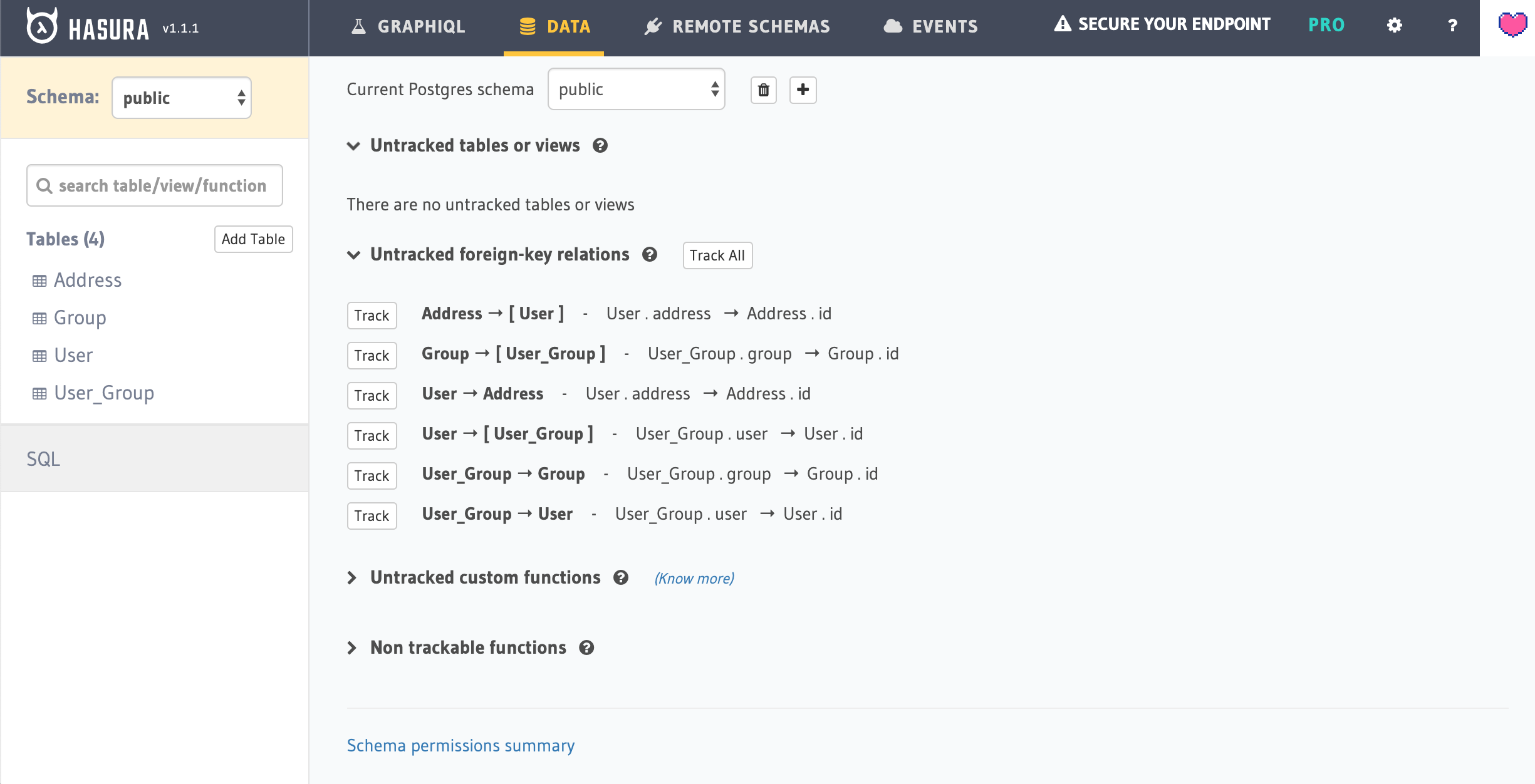
Download Postgres here https://www.postgresql.org/download/ and install the application. Make sure you create a server using the button in the lower-left of the Postgres window and start it. Note that you will need to update $PATH to use the command line tools. This command will take care of that for you.
sudo mkdir -p /etc/paths.d && echo /Applications/Postgres.app/Contents/Versions/latest/bin | sudo tee /etc/paths.d/postgresappNow we can create a Database to test.
createdb mydbLet’s make sure mydb exists using the command line tools.
psql "postgres:///"
\c mydb
select 1 + 1 as two;
quitIt would be great to have a UI to interact with our new database, so let’s install PGAdmin. You can download it here https://www.postgresql.org/ftp/pgadmin/. There are no credentials for our database, so lease them empty.
Use PGAdmin to create the following tables:
CREATE SEQUENCE address_id_seq;
CREATE TABLE public."Address"
(
street character varying COLLATE pg_catalog."default" NOT NULL,
id integer NOT NULL DEFAULT nextval('address_id_seq'),
CONSTRAINT "address_pkey" PRIMARY KEY (id)
);
CREATE SEQUENCE user_id_seq;
CREATE TABLE public."User"
(
id integer NOT NULL DEFAULT nextval('user_id_seq'),
name character varying COLLATE pg_catalog."default",
CONSTRAINT "user_pkey" PRIMARY KEY (id),
CONSTRAINT "fkAddress" FOREIGN KEY (address)
REFERENCES public."Address" (id)
);
CREATE SEQUENCE group_id_seq;
CREATE TABLE public."Group"
(
id integer NOT NULL DEFAULT nextval('group_id_seq'),
name character varying COLLATE pg_catalog."default",
address integer,
CONSTRAINT "group_pkey" PRIMARY KEY (id)
);
CREATE SEQUENCE user_group_id_seq;
CREATE TABLE public.User_Group
(
id integer NOT NULL DEFAULT nextval('user_group_id_seq'),
"group" integer NOT NULL,
"user" integer NOT NULL,
CONSTRAINT user_group_pkey PRIMARY KEY (id),
CONSTRAINT fkgroup FOREIGN KEY ("group")
REFERENCES public."Group" (id),
CONSTRAINT fkuser FOREIGN KEY ("user")
REFERENCES public."User" (id)
);
INSERT INTO public."Address"(street) VALUES ('1600 Pennsylvania Ave');
INSERT INTO public."Address"(street) VALUES ('4 Privet Drive');
INSERT INTO public."User"(name, address) VALUES ('Don',1);
INSERT INTO public."User"(name, address) VALUES ('Harry',2);
INSERT INTO public."Group"(name) VALUES ('Wizard');
INSERT INTO public."Group"(name) VALUES ('User');
INSERT INTO public."User_Group"(user, group) VALUES (1,2);
INSERT INTO public."User_Group"(user, group) VALUES (2,1);
INSERT INTO public."User_Group"(user, group) VALUES (2,2);Now you can jump to the PostGraphile or Hasura section.
Make sure you completed the ‘Getting Started’ section. At this point we have;
We can now create a NodeJS app to run PostGraphile. Let’s create an Express application for this.
mkdir postgraphile
cd postgraphile
npx express-generator
npm install
yarn add postgraphile @graphile-contrib/pg-many-to-many
npx postgraphile --append-plugins @graphile-contrib/pg-many-to-manyNow edit app.js
const {
postgraphile
} = require('postgraphile')
const PgManyToManyPlugin = require('@graphile-contrib/pg-many-to-many')
...
app.use(
postgraphile(
process.env.DATABASE_URL || 'postgres://localhost:5432/mydb',
'public', {
appendPlugins: [PgManyToManyPlugin],
watchPg: true,
graphiql: true,
enhanceGraphiql: true,
}
)
)
...Start the Express
npm startOpen a browser to http://localhost:3000/graphiql
Subscriptions don’t come for free, and the setup is more than I want to dig into at this time. However, This will demonstrate that it is possible.
yarn add @graphile/pg-pubsub
npx postgraphile \
--plugins @graphile/pg-pubsub \
--subscriptions \
--simple-subscriptions \
-c mydbOpen a browser to http://localhost:5000/graphiql and Subscription query like this:
subscription MySubscription {
listen(topic: "hello") {
query {
nodeId
allGroups {
nodes {
name
id
}
}
}
}
}Now we can trigger the update using a Postgres command. First, enter the command console with postgres:///, running this will trigger The Group with id 1 to be updated.
mydb=# select pg_notify(
'postgraphile:hello',
json_build_object('__node__', json_build_array('User', 1))::text );Go ahead and change the row and rerun the trigger.
Hasura feels like a more polished version of PostGraphile, as we will see from the install. There are several ways we can get started; there is a ‘one-button’ deployment to Heroku that installs everything you need, including a Postgres database. Let’s choose a docker install that uses the database we already created to get a better comparison. The following command will start Harusa on a Mac, for other Operating systems go here
docker run -p 8080:8080 \
-e HASURA_GRAPHQL_DATABASE_URL=postgres://postgres:@host.docker.internal:5432/mydb \
-e HASURA_GRAPHQL_ENABLE_CONSOLE=true \
hasura/graphql-engine:latestOpen a browser to http://localhost:8080/console and tell Harusa to start tracking the existing Tables and Foreign Keys.

On the Data tab click button to add all tables

Now you will see the relationships to can track with Hasura, choose any you like, and test them out on the Query tab.
Subscription will also be working out-of-the-box.
Unlike the previous two examples that a targeted at being GraphQL servers, Prisma seems to be target more at something you add to your application. It’s probably better classified as an Object to Relational Mapping (ORM) tool. It manages the connection to the database and generates a client that your application uses. I think you need to add something like GraphQL Yoga to have something similar to the other two tools.
Let’s run through a quick setup the follows the tutorial
npm init
npm install @prisma/cli --save-dev
npx prisma initEdit the prisma/.env file to point to our database.
DATABASE_URL="postgres://postgres:@localhost:5432/mydb?schema=public"npx prisma introspect
npm install @prisma/client
npx prisma generateCreate an index.js file
var {
PrismaClient
} = require('@prisma/client')
const prisma = new PrismaClient()
async function main() {
const allUsers = await prisma.user.findMany()
console.log(allUsers)
}
main()
.catch((e) => {
throw e
})
.finally(async () => {
await prisma.disconnect()
})Run Node
node index.jsIf I was going to start a project that needed a tool like this, Hasura would be the tool I would reach for first. It seems to have the ‘sharp edges’ taken off. The support for Subscriptions and Authorization make it seem like the pick to focus on first.